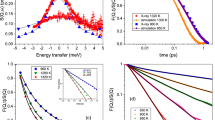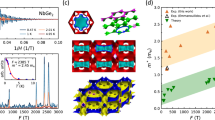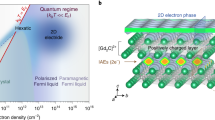Abstract
At high pressures, simple metals such as potassium have a rich phase diagram including an insulating electride phase in which electrons have a localized, anionic character. Measurements in the liquid phase have shown a transition between two states, but experimental challenges have prevented detailed thermodynamic measurements. Using potassium as an example, we present numerical evidence that the liquid–liquid transition is a continuous transformation from free electron to electride behaviour. We show that the transformation manifests in anomalous diffusivity, thermal expansion, speed of sound, coordination number, reflectivity and heat capacity across a wide range of pressures. The abnormalities stem from a significant change in the local electronic and ionic structure. Although primarily a pressure-induced phenomenon, there is also a thermal expansion anomaly. By establishing the electride nature of the high-pressure liquid phase, we resolve the long-standing mystery of how a liquid can be denser than a close-packed solid. Our work is relevant for high-pressure thermodynamic properties of all alkali metal liquids.
This is a preview of subscription content, access via your institution
Access options
Access Nature and 54 other Nature Portfolio journals
Get Nature+, our best-value online-access subscription
$29.99 / 30 days
cancel any time
Subscribe to this journal
Receive 12 print issues and online access
$209.00 per year
only $17.42 per issue
Buy this article
- Purchase on Springer Link
- Instant access to full article PDF
Prices may be subject to local taxes which are calculated during checkout





Similar content being viewed by others
Data availability
All the data presented in Figs. 1–5 are available as source data. All other data that support the plots within this paper and other findings of this study are available from the corresponding authors upon reasonable request.
Code availability
Code is available at https://github.com/zhaolongxjtu/KMLP.
References
Katayama, Y. et al. A first-order liquid–liquid phase transition in phosphorus. Nature 403, 170–173 (2000).
Ashcroft, N. The hydrogen liquids. J. Phys. Condens. Matter 12, A129 (2000).
Knudson, M. D. et al. Direct observation of an abrupt insulator-to-metal transition in dense liquid deuterium. Science 348, 1455–1460 (2015).
McMahon, J. M., Morales, M. A., Pierleoni, C. & Ceperley, D. M. The properties of hydrogen and helium under extreme conditions. Rev. Mod. Phys. 84, 1607 (2012).
Geng, H. Y., Wu, Q., Marqués, M. & Ackland, G. J. Thermodynamic anomalies and three distinct liquid-liquid transitions in warm dense liquid hydrogen. Phys. Rev. B 100, 134109 (2019).
London, F. The λ-phenomenon of liquid helium and the Bose–Einstein degeneracy. Nature 141, 643–644 (1938).
Mishima, O. & Stanley, H. E. The relationship between liquid, supercooled and glassy water. Nature 396, 329–335 (1998).
Soper, A. K. & Ricci, M. A. Structures of high-density and low-density water. Phys. Rev. Lett. 84, 2881 (2000).
Strässle, T. et al. Structure of dense liquid water by neutron scattering to 6.5 GPa and 670 K. Phys. Rev. Lett. 96, 067801 (2006).
Fanetti, S. et al. Structure and dynamics of low-density and high-density liquid water at high pressure. J. Phys. Chem. Lett. 5, 235–240 (2014).
Lapini, A. et al. Pressure dependence of hydrogen-bond dynamics in liquid water probed by ultrafast infrared spectroscopy. J. Phys. Chem. Lett. 7, 3579–3584 (2016).
Bove, L. E. et al. Translational and rotational diffusion in water in the gigapascal range. Phys. Rev. Lett. 111, 185901 (2013).
Cadien, A. et al. First-order liquid-liquid phase transition in cerium. Phys. Rev. Lett. 110, 125503 (2013).
Nomura, R. et al. Spin crossover and iron-rich silicate melt in the Earth’s deep mantle. Nature 473, 199–202 (2011).
Ramo, D. M. & Stixrude, L. Spin crossover in Fe2SiO4 liquid at high pressure. Geophys. Res. Lett. 41, 4512–4518 (2014).
Gregoryanz, E., Degtyareva, O., Somayazulu, M., Hemley, R. & Mao, H.-K. Melting of dense sodium. Phys. Rev. Lett. 94, 185502 (2005).
Ma, Y. et al. Transparent dense sodium. Nature 458, 182–185 (2009).
Guillaume, C. L. et al. Cold melting and solid structures of dense lithium. Nat. Phys. 7, 211–214 (2011).
Narygina, O., McBride, E. E., Stinton, G. W. & McMahon, M. I. Melting curve of potassium to 22 GPa. Phys. Rev. B 84, 054111 (2011).
Woolman, G. et al. Structural and electronic properties of the alkali metal incommensurate phases. Phys. Rev. Mater. 2, 053604 (2018).
Dawes, S. B., Ward, D. L., Huang, R. H. & Dye, J. L. First electride crystal structure. J. Am. Chem. Soc. 108, 3534–3535 (1986).
Dye, J. L. Electrides: ionic salts with electrons as the anions. Science 247, 663–668 (1990).
Miyakawa, M. et al. Superconductivity in an inorganic electride 12CaO·7Al2O3:e–. J. Am. Chem. Soc. 129, 7270–7271 (2007).
Sushko, P. V., Shluger, A. L., Hirano, M. & Hosono, H. From insulator to electride: a theoretical model of nanoporous oxide 12CaO·7Al2O3. J. Am. Chem. Soc. 129, 942–951 (2007).
Kitano, M. et al. Ammonia synthesis using a stable electride as an electron donor and reversible hydrogen store. Nat. Chem. 4, 934–940 (2012).
Kitano, M. et al. Electride support boosts nitrogen dissociation over ruthenium catalyst and shifts the bottleneck in ammonia synthesis. Nat. Commun. 6, 6731 (2015).
Zhang, Y., Wang, H., Wang, Y., Zhang, L. & Ma, Y. Computer-assisted inverse design of inorganic electrides. Phys. Rev. X 7, 011017 (2017).
Tsujia, K., Katayama, Y., Morimoto, Y. & Shimomura, O. Structure of liquid rubidium under high pressure. J. Non Cryst. Solids 205-207, 295–298 (1996).
Gorelli, F. A. et al. Simple-to-complex transformation in liquid rubidium. J. Phys. Chem. Lett. 9, 2909–2913 (2018).
Tsuji, K. et al. Pressure-induced structural change of liquid cesium. J. Non Cryst. Solids 117–118, 72–75 (1990).
Falconi, S., Lundegaard, L. F., Hejny, C. & McMahon, M. I. X-ray diffraction study of liquid Cs up to 9.8 GPa. Phys. Rev. Lett. 94, 125507 (2005).
Hattori, T. Is there a pressure-induced discontinuous volume change in liquid Cs? Phys. Rev. B 97, 100101 (2018).
Decremps, F. et al. Sound velocity and equation of state in liquid cesium at high pressure and high temperature. Phys. Rev. B 98, 184103 (2018).
Tamblyn, I., Raty, J.-Y. & Bonev, S. A. Tetrahedral clustering in molten lithium under pressure. Phys. Rev. Lett. 101, 075703 (2008).
Raty, J.-Y., Schwegler, E. & Bonev, S. A. Electronic and structural transitions in dense liquid sodium. Nature 449, 448–451 (2007).
Bryk, T. et al. Dynamical crossover at the liquid-liquid transformation of a compressed molten alkali metal. Phys. Rev. Lett. 111, 077801 (2013).
Falconi, S. & Ackland, G. J. Ab initio simulations in liquid caesium at high pressure and temperature. Phys. Rev. B 73, 184204 (2006).
Boates, B. On the Stability of sp-Valent Materials at High Pressure. PhD thesis, Dalhousie Univ. (2013).
Zhao, L., Zong, H., Ding, X., Sun, J. & Ackland, G. J. Commensurate-incommensurate phase transition of dense potassium simulated by machine-learned interatomic potential. Phys. Rev. B 100, 220101 (2019).
Robinson, V. N., Zong, H., Ackland, G. J., Woolman, G. & Hermann, A. On the chain-melted phase of matter. Proc. Natl Acad. Sci. USA 116, 10297–10302 (2019).
Rapoport, E. Model for melting-curve maxima at high pressure. J. Chem. Phys. 46, 2891–2895 (1967).
Tanaka, H. Bond orientational order in liquids: towards a unified description of water-like anomalies, liquid-liquid transition, glass transition, and crystallization. Eur. Phys. J. E 35, 113 (2012).
Holten, V. & Anisimov, M. A. Entropy-driven liquid–liquid separation in supercooled water. Sci. Rep. 2, 713 (2012).
Brazhkin, V. V., Fomin, Y. D., Lyapin, A. G., Ryzhov, V. N. & Tsiok, E. N. Widom line for the liquid–gas transition in Lennard–Jones system. J. Phys. Chem. B 115, 14112–14115 (2011).
Bastea, M. & Bastea, S. Electrical conductivity of lithium at megabar pressures. Phys. Rev. B 65, 193104 (2002).
Kietzmann, A., Redmer, R., Desjarlais, M. P. & Mattsson, T. R. Complex behavior of fluid lithium under extreme conditions. Phys. Rev. Lett. 101, 070401 (2008).
Bader, R. F. W. Atoms in Molecules: A Quantum Theory (Oxford Univ. Press, 1994).
Savin, A. et al. Electron localization in solid-state structures of the elements: the diamond structure. Angew. Chem. Int. Ed. 31, 187–188 (1992).
Marqués, M. et al. Potassium under pressure: a pseudobinary ionic compound. Phys. Rev. Lett. 103, 115501 (2009).
McBride, E. E. et al. One-dimensional chain melting in incommensurate potassium. Phys. Rev. B 91, 144111 (2015).
Clark, S. J. et al. First principles methods using CASTEP. Z. Krist. 220, 567–570 (2005).
Perdew, J. P., Burke, K. & Ernzerhof, M. Generalized gradient approximation made simple. Phys. Rev. Lett. 77, 3865 (1996).
Morris, A. J., Nicholls, R. J., Pickard, C. J. & Yates, J. R. OptaDOS: a tool for obtaining density of states, core-level and optical spectra from electronic structure codes. Comput. Phys. Commun. 185, 1477–1485 (2014).
Kresse, G. & Furthmüller, J. Efficiency of ab-initio total energy calculations for metals and semiconductors using a plane-wave basis set. Comput. Mater. Sci. 6, 15–50 (1996).
Kresse, G. & Furthmüller, J. Efficient iterative schemes for ab initio total-energy calculations using a plane-wave basis set. Phys. Rev. B 54, 11169–11186 (1996).
Ackland, G. J. Temperature dependence in interatomic potentials and an improved potential for Ti. J. Phys. Conf. Ser. 402, 012001 (2012).
Khakshouri, S., Alfè, D. & Duffy, D. M. Development of an electron-temperature-dependent interatomic potential for molecular dynamics simulation of tungsten under electronic excitation. Phys. Rev. B 78, 224304 (2008).
Zhang, X., Grabowski, B., Körmann, F., Freysoldt, C. & Neugebauer, J. Accurate electronic free energies of the 3d, 4d, and 5d transition metals at high temperatures. Phys. Rev. B 95, 165126 (2017).
Nosé, S. A unified formulation of the constant temperature molecular dynamics methods. J. Phys. Chem. A 81, 511–519 (1984).
Parrinello, M. & Rahman, A. Polymorphic transitions in single crystals: a new molecular dynamics method. J. Appl. Phys. 52, 7182 (1981).
Acknowledgements
H.Z. and G.J.A. acknowledge the ERC project HECATE for funding. V.N.R. thanks the UK’s EPSRC for CM-CDT studentships. H.Z. and X.D. thank the National Natural Science Foundation of China (51931004 and 51871177) and the 111 project 2.0 (BP2018008). We are grateful for computational support from the UK national high performance computing service (ARCHER) and the UK Materials and Molecular Modelling Hub, which is partially funded by EPSRC (EP/P020194), access for both of which was obtained via the UKCP consortium and funded by EPSRC grant no. EP/P022561/1.
Author information
Authors and Affiliations
Contributions
H.Z., V.N.R., A.H. and G.J.A. conceived the research. H.Z., V.N.R., A.H. and L.Z. conducted the simulation. S.S. and G.J.A. created the two-state liquid model. All the authors participated in the analysis and interpretation of the results as well as writing of the manuscript.
Corresponding authors
Ethics declarations
Competing interests
The authors declare no competing interests.
Additional information
Peer review information Nature Physics thanks Takanori Hattori, Artem Oganov and the other, anonymous, reviewer(s) for their contribution to the peer review of this work.
Publisher’s note Springer Nature remains neutral with regard to jurisdictional claims in published maps and institutional affiliations.
Supplementary information
Supplementary Information
Supplementary Figs. 1–20 and Notes 1–8.
Supplementary Video 1
Liquid potassium ELF at 22.8 GPa and 650 K. The ELF (0.70) for a liquid is challenging to summarize: here one snapshot is scanned over 100 ELF surfaces along the z direction.
Source data
Source Data Fig. 1
Plotted data points.
Source Data Fig. 2
Plotted data points.
Source Data Fig. 3
Plotted data points.
Source Data Fig. 4
Plotted data points.
Source Data Fig. 5
Plotted data points and single images for Fig. 5c–f.
Rights and permissions
About this article
Cite this article
Zong, H., Robinson, V.N., Hermann, A. et al. Free electron to electride transition in dense liquid potassium. Nat. Phys. 17, 955–960 (2021). https://doi.org/10.1038/s41567-021-01244-w
Received:
Accepted:
Published:
Issue Date:
DOI: https://doi.org/10.1038/s41567-021-01244-w
This article is cited by
-
Stress fluctuations and adiabatic speed of sound in liquids: a simple way to estimate it from ab initio simulations
Scientific Reports (2023)
-
A machine-learned interatomic potential for silica and its relation to empirical models
npj Computational Materials (2022)
-
Structural complexity in ramp-compressed sodium to 480 GPa
Nature Communications (2022)



